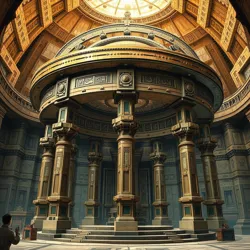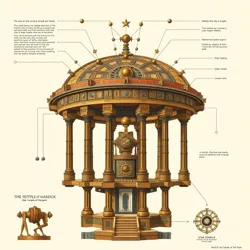Star Temple of Marduk
The Star Temple of Marduk was an advanced mechanical-astronomical complex constructed in Neo-Babylon during the height of the Mesopotamian Mechanical Age (circa 600-539 BCE). This remarkable structure combined elements of religious worship with sophisticated celestial engineering to create one of the ancient world's most complex automated temple systems.
 Archaeological reconstruction of the Star Temple's main ceremonial chamber
Archaeological reconstruction of the Star Temple's main ceremonial chamberArchitecture and Design
The temple's most distinctive feature was its Astrolabe Dome, a massive rotating ceiling embedded with precious gems and crystalline resonators that tracked celestial movements. The dome was supported by twelve mechanical pillars, each representing a month in the Babylonian calendar and housing its own automated guardian.
Mechanical Systems
The temple complex utilized several revolutionary mechanical systems:
-
A sophisticated celestial alignment engine that automatically adjusted the temple's orientation
-
Star-tracking automata that maintained precise astronomical calculations
-
A network of harmonic resonance chambers that converted stellar energy into mechanical power
 Recovered fragments of one of the temple's mechanical guardians
Recovered fragments of one of the temple's mechanical guardiansReligious Significance
The Star Temple served as both an astronomical observatory and a crucial center of Babylonian Mechanistic Worship. Priests known as the Astro-Engineers maintained the complex machinery while performing religious ceremonies. The temple's most sacred chamber housed the Cosmic Synchronizer, a device believed to harmonize earthly and celestial energies.
 Technical diagram showing the temple's celestial alignment mechanism
Technical diagram showing the temple's celestial alignment mechanismArchaeological Discovery
The temple remained hidden until 2031, when the Great Mediterranean Dig uncovered its vast underground chambers. The discovery revolutionized understanding of ancient Babylonian technology, particularly their advanced knowledge of astronomical mechanics.
Legacy
The Star Temple's influence can be seen in later mechanical-religious structures, including the Parthian Sky Temples and the Persian Astrolabes. Modern researchers continue to study its unique combination of astronomical observation and mechanical automation.
See Also
- Babylonian Mechanical Priesthood
- Ancient Stellar Engineering
- Mechanical Temple Guardians
References
- Astronomical Mechanics of Antiquity
- Babylonian Temple Technologies
- Sacred Engineering Practices